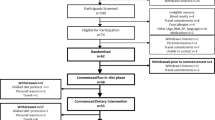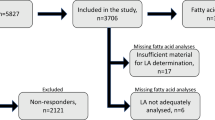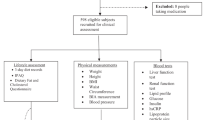Abstract
Background/Objectives:
Abnormalities in lipoprotein profiles (size, distribution and concentration) play an important role in the pathobiology of atherosclerosis and coronary artery disease. Dietary fat, among other factors, has been demonstrated to modulate lipoprotein profiles. We aimed to investigate if background dietary fat (saturated, SFA versus omega-6 polyunsaturated fatty acids, n-6PUFA) was a determinant of the effects of LCn-3PUFA supplementation on lipoprotein profiles.
Subjects/Methods:
A randomized controlled clinical intervention trial in a parallel design was conducted. Healthy subjects (n=26) were supplemented with 400 mg eicosapentaenoic acid plus 2000 mg docosahexaenoic acid daily and randomized to consume diets rich in either SFA or n-6PUFA for a period of 6 weeks. Blood samples, collected at baseline and after 6 weeks of intervention, were assessed for plasma lipoprotein profiles (lipoprotein size, concentration and distribution in subclasses) determined using nuclear magnetic resonance spectroscopy.
Results:
Study participants receiving the SFA or the n-6PUFA enriched diets consumed similar percentage energy from fat (41 and 42% respectively, P=0.681). However, subjects on the SFA diet consumed 50% more energy as saturated fat and 77% less as linoleic acid than those consuming the n-6PUFA diet (P<0.001). The diets rich in SFA and n-6PUFA reduced the concentration of total very-low-density lipoprotein (VLDL) particles (P<0.001, both), and their subclasses and increased VLDL (P=0.042 and P=0.007, respectively) and LDL (P=0.030 and 0.027, respectively) particle size. In addition, plasma triglyceride concentration was significantly reduced by LCn-3PUFA supplementation irrespective of the dietary fat.
Conclusions:
LCn-3PUFA modulated lipoprotein profiles in a similar fashion when supplemented in diets rich in either SFA or n-6PUFA.
This is a preview of subscription content, access via your institution
Access options
Subscribe to this journal
Receive 12 print issues and online access
$259.00 per year
only $21.58 per issue
Buy this article
- Purchase on Springer Link
- Instant access to full article PDF
Prices may be subject to local taxes which are calculated during checkout

Similar content being viewed by others
References
Carmena R, Duriez P, Fruchart J-C . Atherogenic lipoprotein particles in atherosclerosis. Circulation 2004; 109 (suppl 1), III2–III7.
Mackey RH, McTigue KM, Chang YF, Barinas-Mitchell E, Evans RW, Tinker LF et al. Lipoprotein particles and size, total and high molecular weight adiponectin, and leptin in relation to incident coronary heart disease among severely obese postmenopausal women: The Women's Health Initiative Observational Study. BBA Clin 2015; 3: 243–250.
Akinkuolie AO, Paynter NP, Padmanabhan L, Mora S . High-density lipoprotein particle subclass heterogeneity and incident coronary heart disease. Circ Cardiovasc Qual Outcomes 2014; 7: 55–63.
Mora S, Otvos JD, Rifai N, Rosenson RS, Buring JE, Ridker PM . Lipoprotein particle profiles by nuclear magnetic resonance compared with standard lipids and apolipoproteins in predicting incident cardiovascular disease in women. Circulation 2009; 119: 931–939.
Mackey RH, Kuller LH, Sutton-Tyrrell K, Evans RW, Holubkov R, Matthews KA . Lipoprotein subclasses and coronary artery calcium in postmenopausal women from the healthy women study. Am J Cardiol 2002; 90: 71i–76i.
Cromwell WC, Otvos JD, Keyes MJ, Pencina MJ, Sullivan L, Vasan RS et al. LDL particle number and risk of future cardiovascular disease in the Framingham Offspring Study—implications for LDL management. J Clin Lipidol 2007; 1: 583–592.
Bogl LH, Pietiläinen KH, Rissanen A, Kangas AJ, Soininen P, Rose RJ et al. Association between habitual dietary intake and lipoprotein subclass profile in healthy young adults. Nutr Metab Cardiovasc Dis 2013; 23: 1071–1078.
Ahmed HM, Blaha MJ, Nasir K, Rivera JJ, Blumenthal RS . Effects of physical activity on cardiovascular disease. Am J Cardiol 2012; 109: 288–295.
Rizos EC, Ntzani EE, Bika E, Kostapanos MS, Elisaf MS . Association between omega-3 fatty acid supplementation and risk of major cardiovascular disease events: a systematic review and meta-analysis. JAMA 2012; 308: 1024–1033.
Eslick GD, Howe PRC, Smith C, Priest R, Bensoussan A . Benefits of fish oil supplementation in hyperlipidemia: a systematic review and meta-analysis. Int J Cardiol 2009; 136: 4–16.
Russo GL . Dietary n-6 and n-3 polyunsaturated fatty acids: from biochemistry to clinical implications in cardiovascular prevention. Biochem Pharmacol 2009; 77: 937–946.
Phang M, Lincz LF, Garg ML . Eicosapentaenoic and docosahexaenoic acid supplementations reduce platelet aggregation and hemostatic markers differentially in men and women. J Nutr 2013; 143: 457–463.
Mori TA, Burke V, Puddey IB, Watts GF, O’Neal DN, Best JD et al. Purified eicosapentaenoic and docosahexaenoic acids have differential effects on serum lipids and lipoproteins, LDL particle size, glucose, and insulin in mildly hyperlipidemic men. Am J Clin Nutr 2000; 71: 1085–1094.
Neff LM, Culiner J, Cunningham‐Rundles S, Seidman C, Meehan D, Maturi J et al. Algal docosahexaenoic acid affects plasma lipoprotein particle size distribution in overweight and obese adults. J Nutr 2011; 141: 207–213.
Kelley DS, Siegel D, Vemuri M, Mackey BE . Docosahexaenoic acid supplementation improves fasting and postprandial lipid profiles in hypertriglyceridemic men. Am J Clin Nutr 2007; 86: 324–333.
Erkkilä AT, Schwab US, Lehto S, de Mello VD, Kangas AJ, Soininen P et al. Effect of fatty and lean fish intake on lipoprotein subclasses in subjects with coronary heart disease: a controlled trial. J Clin Lipidol 2014; 8: 126–133.
Bays HE, Braeckman RA, Ballantyne CM, Kastelein JJ, Otvos JD, Stirtan WG et al. Icosapent ethyl, a pure EPA omega-3 fatty acid: effects on lipoprotein particle concentration and size in patients with very high triglyceride levels (the MARINE study). J Clin Lipidol 2012; 6: 565–572.
Mostad IL, Bjerve KS, Bjorgaas MR, Lydersen S, Grill V . Effects of n3 fatty acids in subjects with type 2 diabetes: reduction of insulin sensitivity and time-dependent alteration from carbohydrate to fat oxidation. Am J Clin Nutr 2006; 84: 540–550.
Satoh N, Shimatsu A, Kotani K, Sakane N, Yamada K, Suganami T et al. Purified eicosapentaenoic acid reduces small dense LDL, remnant lipoprotein particles, and C-reactive protein in metabolic syndrome. Diabetes Care 2007; 30: 144–146.
Tani S, Nagao K, Matsumoto M, Hirayama A . Highly purified eicosapentaenoic acid may increase low-density lipoprotein particle size by improving triglyceride metabolism in patients with hypertriglyceridemia. Circ J 2013; 77: 2349–2357.
Mostad IL, Bjerve KS, Lydersen S, Grill V . Effects of marine n-3 fatty acid supplementation on lipoprotein subclasses measured by nuclear magnetic resonance in subjects with type II diabetes. Eur J Clin Nutr 2007; 62: 419–429.
Oelrich B, Dewell A, Gardner CD . Effect of fish oil supplementation on serum triglycerides, LDL cholesterol and LDL subfractions in hypertriglyceridemic adults. Nutr Metab Cardiovasc Dis 2013; 23: 350–357.
Rivellese AA, Maffettone A, Vessby B, Uusitupa M, Hermansen K, Berglund L et al. Effects of dietary saturated, monounsaturated and n-3 fatty acids on fasting lipoproteins, LDL size and post-prandial lipid metabolism in healthy subjects. Atherosclerosis 2003; 167: 149–158.
Dias CB, Wood LG, Garg ML . Effects of dietary saturated and n-6 polyunsaturated fatty acids on the incorporation of long chain n-3 polyunsaturated fatty acids into blood lipids. Eur J Clin Nutr 2016; 70: 812–818.
Mallol R, Amigo N, Rodriguez MA, Heras M, Vinaixa M, Plana N et al. Liposcale: a novel advanced lipoprotein test based on 2D diffusion-ordered 1H NMR spectroscopy. J Lipid Res 2015; 56: 737–746.
Jeyarajah EJ, Cromwell WC, Otvos JD . Lipoprotein particle analysis by nuclear magnetic resonance spectroscopy. Clin Lab Med 2006; 26: 847–870.
Wood LG, Fitzgerald DA, Gibson PG, Cooper DM, Garg ML . Increased plasma fatty acid concentrations after respiratory exacerbations are associated with elevated oxidative stress in cystic fibrosis patients. Am J Clin Nutr 2002; 75: 668–675.
Mori TA, Vandongen R, Beilin LJ, Burke V, Morris J, Ritchie J . Effects of varying dietary fat, fish, and fish oils on blood lipids in a randomized controlled trial in men at risk of heart disease. Am J Clin Nutr 1994; 59: 1060–1068.
Chan DC, Watts GF, Mori TA, Barrett PHR, Redgrave TG, Beilin LJ . Randomized controlled trial of the effect of n–3 fatty acid supplementation on the metabolism of apolipoprotein B-100 and chylomicron remnants in men with visceral obesity. Am J Clin Nutr 2003; 77: 300–307.
Nordestgaard BG, Varbo A . Triglycerides and cardiovascular disease. Lancet 2014; 384: 626–635.
Schoonjans K, Staels B, Auwerx J . Role of the peroxisome proliferator-activated receptor (PPAR) in mediating the effects of fibrates and fatty acids on gene expression. J Lipid Res 1996; 37: 907–925.
López-Soldado I, Avella M, Botham KM . Suppression of VLDL secretion by cultured hepatocytes incubated with chylomicron remnants enriched in n−3 polyunsaturated fatty acids is regulated by hepatic nuclear factor-4α. Biochim Biophys Acta 2009; 1791: 1181–1189.
Fernandez ML, West KL . Mechanisms by which dietary fatty acids modulate plasma lipids. J Nutr 2005; 135: 2075–2078.
Griffin BA . The effect of n−3 fatty acids on low density lipoprotein subfractions. Lipids 2001; 36: S91–S97.
Jackson KG, Maitin V, Leake DS, Yaqoob P, Williams CM . Saturated fat-induced changes in Sf 60–400 particle composition reduces uptake of LDL by HepG2 cells. J Lipid Res 2006; 47: 393–403.
Olano-Martin E, Anil E, Caslake MJ, Packard CJ, Bedford D, Stewart G et al. Contribution of apolipoprotein E genotype and docosahexaenoic acid to the LDL-cholesterol response to fish oil. Atherosclerosis 2010; 209: 104–110.
Ishida T, Ohta M, Nakakuki M, Kami H, Uchiyama R, Kawano H et al. Distinct regulation of plasma LDL cholesterol by eicosapentaenoic acid and docosahexaenoic acid in high fat diet-fed hamsters: participation of cholesterol ester transfer protein and LDL receptor. Prostaglandins Leukot Essent Fatty Acids 2013; 88: 281–288.
van Schalkwijk DB, Pasman WJ, Hendriks HFJ, Verheij ER, Rubingh CM, van Bochove K et al. Dietary medium chain fatty acid supplementation leads to reduced VLDL lipolysis and uptake rates in comparison to linoleic acid supplementation. PLoS ONE 2014; 9: e100376.
Ooi E, Watts G, Ng T, Barrett P . Effect of dietary fatty acids on human lipoprotein metabolism: a comprehensive update. Nutrients 2015; 7: 4416.
Mustad VA, Ellsworth JL, Cooper AD, Kris-Etherton PM, Etherto TD . Dietary linoleic acid increases and palmitic acid decreases hepatic LDL receptor protein and mRNA abundance in young pigs. J Lipids Res 1996; 37: 2310–2323.
Maki KC, Lawless AL, Kelley KM, Dicklin MR, Kaden VN, Schild AL et al. Effects of prescription omega-3-acid ethyl esters on fasting lipid profile in subjects with primary hypercholesterolemia. J Cardiovasc Pharmacol 2011; 57: 489–494.
Mantyselka P, Niskanen L, Kautiainen H, Saltevo J, Wurtz P, Soininen P et al. Cross-sectional and longitudinal associations of circulating omega-3 and omega-6 fatty acids with lipoprotein particle concentrations and sizes: population-based cohort study with 6-year follow-up. Lipids Health Dis 2014; 13: 28.
Lee MW, Park JK, Hong JW, Kim KJ, Shin DY, Ahn CW et al. Beneficial effects of omega-3 fatty acids on low density lipoprotein particle size in patients with type 2 diabetes already under statin therapy. Diabetes Metab J 2013; 37: 207–211.
Annuzzi G, Rivellese AA, Wang H, Patti L, Vaccaro O, Riccardi G et al. Lipoprotein subfractions and dietary intake of n−3 fatty acid: the Genetics of Coronary Artery Disease in Alaska Natives study. Am J Clin Nutr 2012; 95: 1315–1322.
Kuang Y-L, Eric Paulson K, Lichtenstein AH, Lamon-Fava S . Regulation of the expression of key genes involved in HDL metabolism by unsaturated fatty acids. Br J Nutr 2012; 108: 1351–1359.
Ensign W, Hill N, Heward CB . Disparate LDL phenotypic classification among 4 different methods assessing LDL particle characteristics. Clin Chem 2006; 52: 1722–1727.
Sninsky JJ, Rowland CM, Baca AM, Caulfield MP, Superko HR . Classification of LDL phenotypes by 4 methods of determining lipoprotein particle size. J Invest Med 2013; 61: 942–949.
Acknowledgements
This study was supported by a research grant from the Hunter Medical Research Institute and a travel grant from the Faculty of Health, University of Newcastle, Australia. We are grateful to EPAX Norway AS (Norway) for providing the fish oil concentrate capsules; Dr Miguel A Pardo for assistance with the NMR; Ms Melissa Fry for assistance with the fatty acid analysis; and the volunteers from the Hunter Medical Research Institute (HMRI) research register. CBD was supported by a scholarship from the Coordenação Nacional de Desenvolvimento Científico e Tecnológico-CNPq.
Author information
Authors and Affiliations
Corresponding author
Ethics declarations
Competing interests
NA is a stock owner of Biosfer Teslab. The remaining authors declare no conflict of interest.
Additional information
Supplementary Information accompanies this paper on European Journal of Clinical Nutrition website
Supplementary information
Rights and permissions
About this article
Cite this article
Dias, C., Amigo, N., Wood, L. et al. Effect of diets rich in either saturated fat or n-6 polyunsaturated fatty acids and supplemented with long-chain n-3 polyunsaturated fatty acids on plasma lipoprotein profiles. Eur J Clin Nutr 71, 1297–1302 (2017). https://doi.org/10.1038/ejcn.2017.56
Received:
Revised:
Accepted:
Published:
Issue Date:
DOI: https://doi.org/10.1038/ejcn.2017.56
This article is cited by
-
Recent insights into dietary ω-6 fatty acid health implications using a systematic review
Food Science and Biotechnology (2022)
-
The effects of fat consumption on low-density lipoprotein particle size in healthy individuals: a narrative review
Lipids in Health and Disease (2021)



